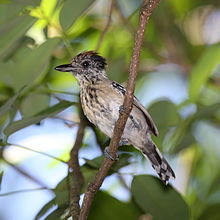Black-crested antshrike
[3] In 1760 the French zoologist Mathurin Jacques Brisson included a description of the black-crested antshrike in his Ornithologie based on a specimen that he mistakenly believed had been collected in Canada.
[4] Although Brisson coined Latin names, these do not conform to the binomial system and are not recognized by the International Commission on Zoological Nomenclature.
[5] When in 1766 the Swedish naturalist Carl Linnaeus updated his Systema Naturae for the twelfth edition he added 240 species that had been previously described by Brisson in his Ornithologie.
Linnaeus included a brief description, used the binomial name Lanius canadensis and cited Brisson's work.
The South American Classification Committee of the American Ornithological Society, the International Ornithological Committee, and the Clements taxonomy recognize these six subspecies:[3][8][9] However, BirdLife International's Handbook of the Birds of the World (HBW) treats S. c. pulchellus as a separate species, the "streak-fronted antshrike".
The subspecies are found thus:[11][12][13][14][15] The provenance of a specimen noted as being collected in southern Pará, Brazil, is disputed as there are no other records of the species that far south and east of the upper Amazon.
[16] The "streak-fronted" pulchellus subspecies of the black-crested antshrike inhabits deciduous and savanna woodlands, gallery forest, and bushy areas in semi-arid regions.
[11] The black-crested antshrike feeds on a wide variety of insects and other arthropods and also includes small lizards and fruit in its diet.
It hops through dense vegetation, gleaning prey from leaves, stems, vines, and branches by reaching and sometimes making short upward jumps from a perch.
Its nest is a cup woven variously from grass and other plant and fungal fibers, and typically suspended in a branch fork.
The primary song of most black-crested anshrike subspecies is "a series of c. 10–15 notes, initially flat with complaining quality, then rising in pitch while accelerating rapidly".
